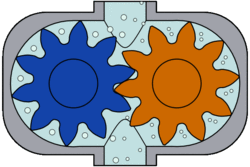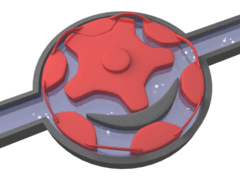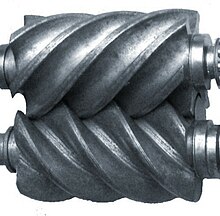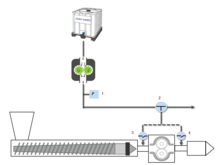Gear pump
The gear pump is a machine for pumping liquids and for power-transmitting drive of hydraulic motors . It is a subspecies of the positive displacement pump .
construction
The gear pump basically consists of three components:
- Housing with inlet and outlet
- Two gears (one driven)
Depending on the arrangement and size of the gears, a distinction is made between external gear pumps , internal gear pumps , gerotor pumps and screw pumps .
With the external gear pump with involute teeth, the medium to be pumped is transported in the spaces between the teeth and the housing . Due to its simple construction, the pump is robust and inexpensive.
With internal gear and gerotor pumps , the driving gear runs eccentrically in the internal teeth of a toothed ring . With gerotor pumps, the medium is conveyed through the displacement space between the tooth gaps, which changes in volume . With the sickle pump, the medium to be conveyed is conveyed in two spaces between the gaps between the teeth of the two gears, the teeth being sealed by the sickle. Both designs also differ in the proportions of the gear and toothed ring. While the outer ring of a gerotor pump has exactly one more tooth than the inner gear and usually has trochoidal teeth, there are significantly more teeth on the outside than on the inside of an internal gear or sickle pump.
Another name for the gerotor pump is Eaton pump after its developer or rotor pump . In a rotor pump, the gears are called rotors. Most rotors have very few teeth.
The special feature of the screw pump is that it has chambers with helical teeth.
properties
A gear pump conveys the medium to be pumped evenly (apart from the hydrostatic pulsation) and can withstand medium pressures of up to approx. 200–300 bar . As in any hydraulic system, the pressure is created by conveying the medium against a load. If the load increases, so does the pressure.
Screw pump
The screw pump (also screw pump , spiral pump piston or screw compressors called) is a positive displacement pump , in which the shape of the rotary positive displacement of a spindle screw is similar. It is the helical variant of the gear pump and is one of the screw compressors .
The screw pump consists of two or more counter-rotating rotors and a housing that encloses the rotors. The rotors are designed with a regular, thread-shaped profile and mesh like a gear . The cavities that are formed by these three construction elements form the delivery spaces for the delivery medium. When the rotor rotates, they migrate in a machine direction and convey the medium from the suction side (inlet) to the pressure side (outlet).
Due to the screw-shaped design, the noise development is lower compared to straight-toothed gear pumps.
For incompressible media, the shape of the cavity (volume) is not changed during the rotor rotation with a uniform thread pitch. For compressible media, a change in volume (compression) can be achieved by continuously changing the thread pitch of the rotor profile over the rotor axis or by gradually changing the thread pitches in sections on the rotors, or by suitable arrangement of the suction and outlet openings.
This type of pump is particularly suitable for incompressible, even viscous media for generating high pressures. Applications are for example: increasing the pressure of water for counter pressure osmosis or as a pump for the oil supply in hydrostatic bearings.
This type of pump has also been used primarily for fuel pumps in the passenger car and commercial vehicle sector since the mid-1990s . Here, for example, a single screw pump replaced the double pump packages previously used in high-performance vehicles, which consisted of two individual pumps of a different design.
In the past, Archimedes' screws were also referred to as screw pumps by some manufacturers . However, for historical reasons, this term has not caught on in the German-speaking world. In English, however, the literal translation screw-pump is common.
For several years this type of pump (oil-cooled type) has also been used for vacuum generation.
- Main article: Function and history of the compressor
Applications
- Dosing pump in the plastics industry for dosing liquid color under pressure into the plastic melt.
- Drive means for hydraulic force converters ( hydraulic motors or single / double-acting lifting cylinders) in construction machinery, tractors and in trade and industry, in particular vehicle construction.
- Circulation of cooling circuits.
- Funding as an oil pump in combustion engines , common rail high pressure pumps (vehicle diesel injection) in automobiles and in oil burners ; Conveying highly viscous liquids ( melts ) that are to be conveyed at high temperatures and under high pressures .
The gerotor pump is also most frequently used as an engine oil pump in passenger car engines. Screw pumps are often used in stage hydraulics due to their low noise level. Internal and external gear pumps are used very often in hydraulic systems. Gear pumps are also used in the production of rubber compounds, where they press the compounds through filters, so-called screens.
history
The invention of the gear pump is not documented uniformly. On the one hand, it goes back to Johannes Kepler in 1604; on the other hand, Gottfried Heinrich Graf zu Pappenheim is named, who is said to have constructed the capsule blower with two axes of rotation for conveying air and water. According to other sources, his gear pump is said to have supplied a fountain with water in 1636; Count Pappenheim died in 1632.
See also
Web links
- Dismantling and dismantling the oil pump - news from the workshop , Die Autodoctors, episode 22 of October 13, 2017
Individual evidence
- ^ Hubert Comte: From hand ax to laser beam ; Knesebeck Verlag (December 2002), Stuttgart 1982. p. 209
- ^ Felix R. Paturi : Chronicle of Technology 1988. P. 119
- ^ Pappenheim biography




